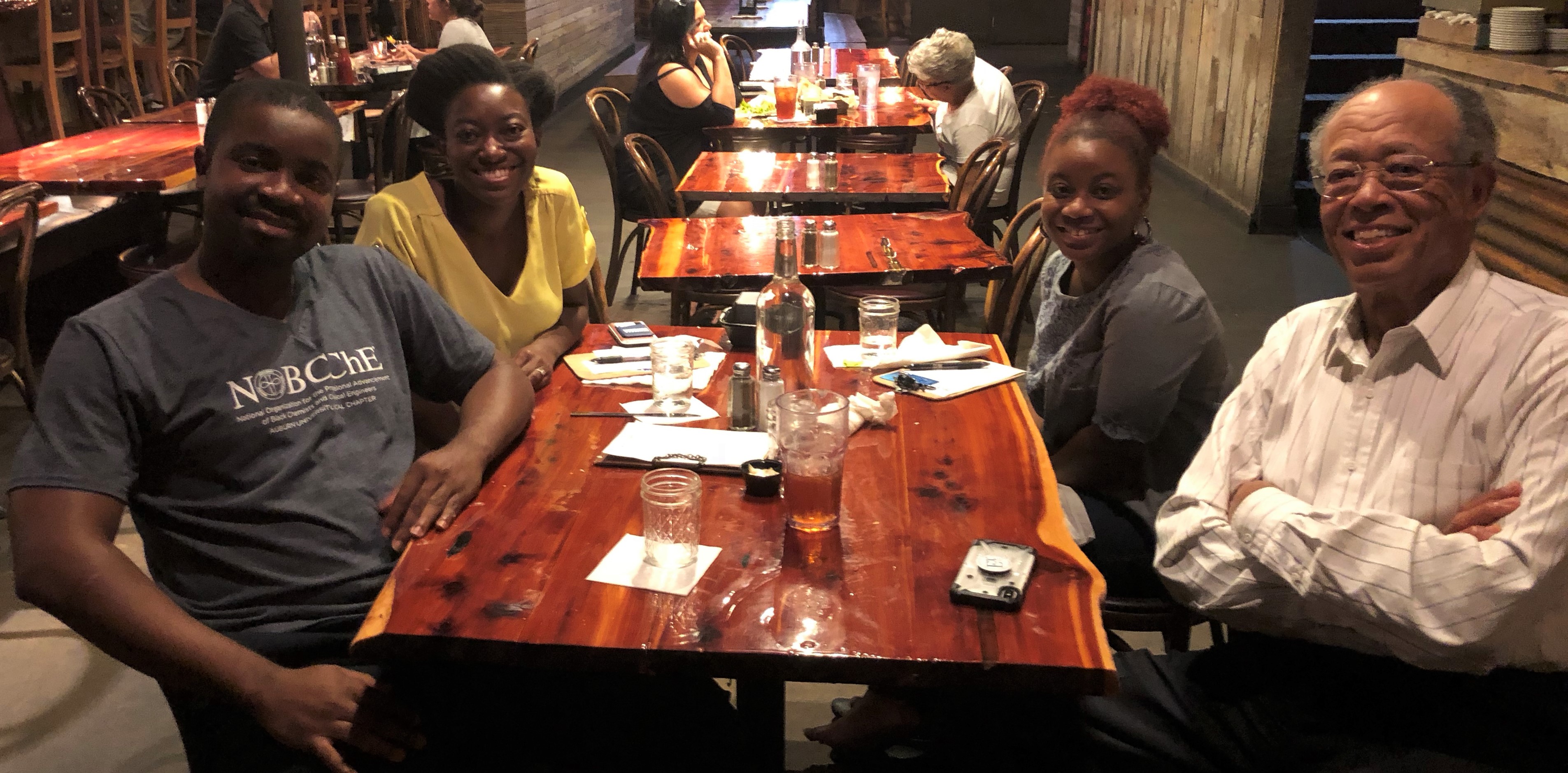The Stellar Career of a Cometary Astrochemist
You wouldn’t expect a man who is, among other things, a renowned scientific researcher, Professor Emeritus of a prestigious University and ex-NASA employee to have a keen sense of fashion. However, as Dr. William Jackson sat back in his chair and lifted his right leg to cross over his left, my eyes were drawn to his socks: Argyle, a different shade of blue than the ones I was currently wearing. Of course, I had to comment. “Those are some fancy socks you got there,” I said, lifting the bottom of my pant leg to expose our mutual interest in the Scottish pattern. Between sips of coffee, made strong with no cream or sugar, he wondered if mine had seams. They did, being that they were of the bargain-bin variety. He asserted that no, I’ve got to go for the good ones, seamless ones. Allegedly they’re much more comfortable. I told him his socks were probably about as valuable as my shoes, to which he responded that they do go on sale, after all. After some more friendly conversation about golf and how he made sure to bring his clubs with him just in case he had the opportunity to hit the links, I wanted to learn about his life before he held a doctoral degree.
Dr. William Jackson was born September 24th, 1936 and lived in the Smithfield Projects of Birmingham, AL. “That was the best housing,” Dr. Jackson remarked. “Everybody who could get in lived there!” It was brand-new, all-brick, had indoor plumbing, electricity and it even still stands today. “It was a segregated society,” he told me, “but I wasn’t at the bottom of the food chain of the segregated society.” His father was a business owner of Apex Cab Company, taught auto mechanics at Parker High School and went on to get a master’s degree, whereas his mother was employed by the government. As such, he considered his family to be upper-middle class.
After the 10th grade, Dr. Jackson attended Morehouse College as one of approximately 25 early entrance members of the first Ford Foundation class. “Challenging,” was the word he used to describe his experience there. For example, there were about 15 students in his freshman chemistry class on the last day of classes… But there were 80 on the first. Dr. Jackson brought up a joke that the late Atlanta mayor Maynard Jackson would tell during political speeches about the professor who taught that class: “[He] made me the mayor of Atlanta, because he sent me out of pre-med, into pre-law.” Challenging, indeed.
As you compete at a higher and higher level, you have to work harder and harder.
That’s the key to success.
However, Dr. Jackson was humble about his time at Morehouse. When I commented that this must have been quite the ordeal, a difficult process, he frankly corrected me. “No, it was a normal process. You went to college, I went to college. I was expected to. I didn’t know how I was going to pay for it,” he said, gesturing knowingly towards me, “but… I got a full scholarship that lasted for two years.” To supplement, he worked and saved over the summers to pay for the rest of his degree and had a bit of help with finances from his family. Some things never change.
Following earning his undergraduate degree, he worked to get his PhD at the Catholic University of America, where he studied gas phase reaction kinetics. “I wouldn’t say it’s harder, but you have to compete, and you have to work hard,” he remarked about his time in graduate school. “I’m sure that when you were in high school, you didn’t study much,” he directed at me, correctly. “As you get older, and as you compete at a higher and higher level, you have to work harder and harder. That’s the key to success. There are a whole lot of brilliant people who never did anything. So, if you want to accomplish something, you have to work hard… The persistence, and ‘stick-to-it-ness.’… That’s what you have to do.” I mentioned that I was always told that hard work beats talent when talent doesn’t work hard. “That’s true,” he responded.
After graduation, he worked at the largest aerospace company in the world, the Martin Company, which is now called Lockheed Martin. He was paid more handsomely than he ever had been before to study the thermal decomposition of phenol formaldehyde resins, but this wasn’t to last. After working there for a couple years, he took a 33% pay cut to complete a post-doctoral program to study surface chemistry. Following this, in 1964 he went to work at NASA’s Goddard Space Flight Center.
Dr. Jackson went to Goddard with the idea to do astrochemistry, working to understand the chemical processes that occur in comets, planetary atmospheres and the interstellar medium. Basically, how does chemistry fit in with astronomy? There he began a controversial research program focused on how the free radicals in comets are produced. About the controversies associated with this research, he somewhat slyly told me, “I think I solved some of those.” He also began an observation program that used radio telescopes to look for water and proposed to use an International Ultraviolet Explorer satellite, also known as an IUE telescope, to look at comets. Some of the astronomers at Goddard said it wouldn’t be a good instrument for doing that sort of observation because it was designed to look at stars, which are a point source for observation, whereas comets are a broad source.
By the time the IUE telescope was used for its first observation of the type Dr. Jackson proposed, he had already left NASA to work at Howard University, but he fortunately still had the right to observe. “I drove out to Goddard, which was… 15 miles [from Howard],” he began. “So, it was me and a few other astronomers, some of which had never even proposed, but they let ‘em in anyway.” That earned a chuckle from me. He continued, “We turned the finder telescope… Which has a broader field of view than the bigger telescope. It was a 36-inch telescope, so the mirror is three feet. Which is…” he spread his arms about a foot outside each side of his torso, “about like that. We could see a bright object and got a huge signal on the detector. When we turned the telescope on, the Lyman-alpha [the specific radiation they were looking for] was off the scale. And so, it was confirmed,” to which I commented that he sure showed those astronomers. “Yep,” he replied with a nod and a smile.
Whereas Dr. Jackson’s personal scientific contributions are undeniably important, he was determined to make sure others would have the opportunity to see success in STEM as well; I wanted to know more about a professional organization he was a founder of, called NOBCChE (pronounced NO-be-shay). “The official name at the time it was founded was the National Organization for the Professional Advancement of Black Chemists and Chemical Engineers. You cannot make an acronym out of that,” he told me as we shared another laugh. “We started the organization with the idea of increasing the number of minority students who received PhDs in, well, we said chemistry but in all of the STEM fields; to promote and award minority scientists and engineers; to encourage students in the K-12 to go into STEM fields; and to help give money to provide awards to students in the college and graduate school areas.” When NOBCChE was founded, there were no organizations that were oriented towards helping Black individuals in not only the college and graduate sphere, but also in government and industry. At this point, the only requirement to join was to support the aims of the organization, pay your dues and be ready to work.

Left to Right: Graduate Students Ogonna Nwajiobi, Jamonica Moore and Maya West with Dr. Jackson at Auburn restaurant The Hound
He then went on to tell me about an early and very important effort of the organization, which was made with the help of the federal government. In the mid ‘70s, the President of NOBCChE received a call from the staff of Senator Ted Kennedy, who oversaw the budget authorization of the National Science Foundation (NSF). “His staff asked if we could come up with some ideas about how we could increase the number of minorities who obtained degrees in the STEM fields. Joe Martinez, who was one of the founders of SACNAS (Society for Advancement of Chicanos/Hispanics and Native Americans in Science) and I met with the staff,” he explained to me. “I came up with the idea [that] they needed to provide bigger funding, which is what NSF does, to the minority-serving institutions in science and engineering.” The NSF created a program to do just this. The first grant was for five to six million dollars over three years, which was given to the Atlanta University Center. Later grants were given to universities in Puerto Rico, New Mexico and New York. “That was, I think, one of the landmark accomplishments of NOBCChE. In addition, I think, through NOBCChE and its sponsors we’ve provided, over its history, over a million dollars in graduate fellowships, sponsored by various industrial organizations,” he went on to say. However, Dr. Jackson’s commitment to increasing minority presence in STEM was not confined to his work with NOBCChE alone.
“When I got [to UC Davis] in 1985 and asked around, to my knowledge, only two people had received PhDs in Chemistry who could be classified as underrepresented minorities.” This number shocked me. Fortunately, Dr. Jackson took it as a goal to work in the spirit NOBCChE during his time at UC Davis. “I first got that number up, before 2000, to about 9%,” he said about underrepresented minorities enrolled in Chemistry graduate programs. “When I became chair in 2000, I received funding from the Sloan Graduate Fellowship Program for Underrepresented Minorites, and I got the number up to 15%,” In addition, under his leadership as chair, the total number of graduate students in Chemistry was increased from around 125 to around 225. This growth, taken together with his work in NOBCChE, shows his tireless dedication to the inclusion of those who are not typically represented in STEM. His efforts gave and continue to give rise to the possibility of people of all sorts to follow in his footsteps. Though, in my opinion, it will be nearly impossible to fill the shoes that helped pave the way in such a meaningful fashion.
Dr. Jackson then told me he has been retired since 2006. “I still recruit students; I still do research; I still write grants; I still teach graduate students,” he went on to explain, to which I responded by informing him that right, he sounds real retired. “Yeah, that’s what my wife says,” he laughed. “She also reminds me that I’m not making any money,” he added. Truly, behind every great man is a great woman.
I guarantee you will have a very satisfying, and in all likelihood, a successful life.
In addition to all the other operations he continues to engage in post-retirement, he recently visited Auburn University. While at Auburn, he met one-on-one with many professors and led an open symposium to discuss his work. In a meeting with Auburn Chemistry Professor Dr. Vincent Ortiz, he discussed the importance of encouraging diverse individuals to take up scientific careers. “NOBCChE meetings are valuable,” Dr. Ortiz said about specific steps that chemists and chemistry departments can take to increase diversity. “They provide considerable encouragement to people moving into the STEM fields.” Essentially, the main goal boils down to increasing visibility of minority scientists and their exposure to young people. Dr. Jackson’s symposium, called Taking Pictures While Hiking Through 2-D and 3-D Potential Surfaces of Diatomic and Triatomic Molecules, focused on different astrochemical measurements he’s made. He explained that whereas the molecules involved in astrochemistry are very isolated, they can be accurately modeled on Earth and the study of these molecules not only have implications in astrochemistry but atmospheric chemistry as well.
I wanted to talk to Dr. Jackson a bit more about any advice he had for younger students who may not know exactly what to do with their lives. Before he could answer though, we had a brief interruption due to a phone call he received from an automated voice with “an important message regarding his credit card account.” So yes, even renowned scientific researchers, Professor Emeriti of prestigious Universities and ex-NASA employees receive spam calls. “If you are a student, and you are trying to figure out what you want to do in life, find whatever you would do, even if you didn’t have to work. If you can find a field that fascinates you so much that if you had all the money in the world, you would still want to do it, that’s what you should go in to. That’s what you should devote your life to. Let me be clear: I believe everyone should be paid for their work,” we both laughed once again, “but find a thing that you would get up in the morning to do when it’s hard to get up in the morning. Then, I guarantee you will have a very satisfying, and in all likelihood, a successful life.”
He should know, after all.

By Matt Gonzales
I'd like to thank Dr. William Jackson for sitting for an interview with me; Dr. Vincent Ortiz for providing further information; Jarrett Rogers for logo design; and Maya West for providing the photograph.

